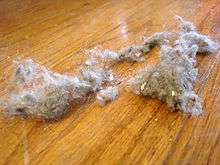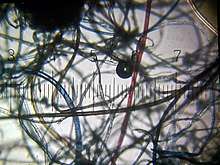Dust bunny
Dust bunnies (or dustbunnies), in American English, are small clumps of dust that form under furniture and in corners that are not cleaned regularly. They are made of hair, lint, dead skin, spider webs, dust and sometimes light rubbish and debris and are held together by static electricity and felt-like entanglement.[1] They can house dust mites or other parasites and can lower the efficiency of dust filters by clogging.[2] The movement of a single large particle can start the formation of a dust bunny.[3]


Dust bunnies are harmful to electronics, as they can obstruct air flow through heat sinks, raising temperatures significantly, and therefore shortening the life of electronic components.[4]
An American trademark for "Dustbunny" was registered in 2006 for the "Dustbunny Cleaner", a robotic ball with an electrostatic sleeve that rolls around under furniture to collect dust bunnies and other material.[5][6]
Dust bunnies have been used as an analogy for the accretion of cosmic matter in planetoids.[7][8]
In popular culture
- Players in Dust 514 are often referred to as dust bunnies.
- Two "dust bunnies", who were actually dusty rabbits, lived under the couch in TV show The Big Comfy Couch. Only Molly believed in their existence, often keeping them safe from Loonette so she could continue to play with them.
- Living dust bunnies are encountered in Beyond Zork.
- Hayao Miyazaki's films My Neighbor Totoro and Spirited Away feature Susuwatari, or soot sprites, which are a type of dust bunny.
- In Rugrats, Tommy and Chuckie imagine dust bunnies as monsters with very long stretchy ears that they use to grab children by their ankles and drag them underground.
- Toopy and Binoo season 1, episode 2 "The Castle/Ballooning with Binoo/Soapy Toopy/Topsy Turvey/Dusteroos".
- In Disney's Vampirina episode 16b "Dust Bunnies", a magical spell cast by Demi the Ghost turns the dust in Vampirina's room to a bunch of mischievous mess-making gray dust bunnies.
- In the 2018 version of Muppet Babies S1E5 "How Kermit Got His Groove; One Small Problem", Summer the penguin is accidentally shrunk by Bunsen and Beaker. When Kermit's toy car ends up under a couch, Summer uses her tiny size to find the little vehicle but is confronted by a pack of dust bunnies who try to prevent her from taking it.
- The eponymous character in the 2018 film Deadpool 2 references dust bunnies when returning to cleaning: "Now, if you excuse me, it's dust bunny season and I'm hunting wabbits."
In other languages
- In Danish they are called nullermænd (nuller- from the verb nulre, meaning to move something between one's fingers, and -mænd meaning "men").
- In Finnish they are called villakoira, after the language's name for the dog breed poodle (literal meaning: "wool dog").
- In French they are called moutons (meaning: "sheep").
- In German they are called Wollmäuse (meaning: "wool mice").[9]
- In Hungarian they are called porcica (meaning: "dust kitten").
- In Italian they are called gatti di polvere (meaning: "dust cats").
- In Norwegian they are called hybelkaniner (meaning: "lodging bunnies"—hybel + kanin).[10]
- In Polish they are called koty (meaning: "cats").
- In Portuguese they are called cotão.
- The Scots word is oose.[11][12]
- In Spanish they are called pelusa.
- In Swedish they are called dammråttor (meaning: "dust rats").
- In Turkish they are called hav.
References
- Fella, Answer (2009-02-05). "Dust Bunny Facts - Physics of Dust Bunnies". Esquire.com. Archived from the original on 2016-08-20. Retrieved 2017-01-19.
- Dust Control in Finite Air Volumes at Zero Gravity - Mean-Field Like Analysis. T.R.Krishna Mohan, Surajit Sen. 8 April 2004.
- Dust and fibers as a cause of indoor environment problems. T. Schneider. Scandinavian Journal of Work, Environment & Health. 2008.
- Three Easy Ways to Save Your Computer From an Early Retirement Archived 2010-04-21 at the Wayback Machine. Christian Science Monitor. Chris Gaylord. April 15, 2010.
- USPTO Dustbunny Trademark Archived 2011-07-16 at the Wayback Machine
- A Method and Apparatus for self-propelled cleaning. Bradford Morse et al. United States Patent Application Publication, US2006/0054187 2006 A1
- Formation of Cosmic Dust Bunnies. Matthews, L.S. Hayes, R.L. Freed, M.S. Hyde, T.W. IEEE Transactions on Plasma Science. April 2007.
- Comet Dust Bunny Archived 2011-03-19 at the Wayback Machine. George Musser. Scientific American. October 24, 2005.
- "Wollmaus". Wörterbuch Englisch–Deutsch. dict.cc. 2010-04-28. Archived from the original on 2017-01-31. Retrieved 2017-01-19.
- "Dust bunny på Norsk bokmål". Engelsk–Norsk bokmål Ordbok (in Norwegian Bokmål). Nb.glosbe.com. Archived from the original on 2017-11-28. Retrieved 2017-01-19.
- Kirkpatrick, Betty. "Useful Scots word: Oose". Caledonian Mercury. Archived from the original on 23 September 2011. Retrieved 22 October 2014.
- Harris, Andrew S (2004). "O". Scots Dictionary. Archived from the original on 22 February 2015. Retrieved 22 October 2014.
External links
